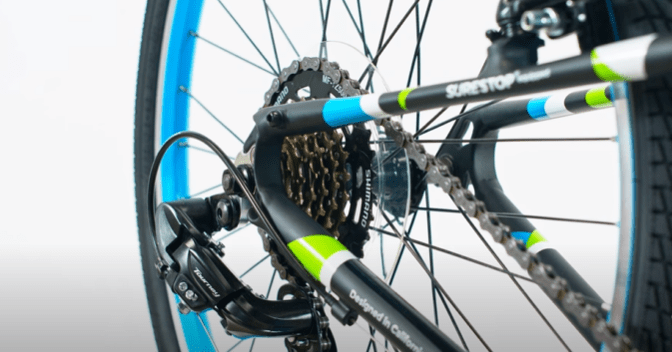

Are you having trouble with your Shimano derailleur on your mountain bike? Do you find that some sprockets don’t engage, or that your chain comes off unexpectedly? If so, it may be time to adjust your gears. In this article, we’ll show you how to adjust your Shimano derailleur so you can get your bike back in top condition and avoid any problems on your rides.
Before we get started, it’s important to understand the basic principles of how your gears work. Your mountain bike’s gears rely on the tension applied to the cable from the shift button on your handlebars. The proper tension of the cable is crucial to the smooth operation of your rear derailleur, so it’s where most of the problems related to derailleur malfunction arise.
With that in mind, let’s get started with the steps you’ll need to follow to adjust your Shimano gears and get your mountain bike running smoothly again.
The components for regulating Shimano and Sram derailleurs – two major manufacturers – are essentially the same. They include a tensioning wheel located on the control, which adjusts the cable tension by tightening or loosening it. If you have an older derailleur, you may notice a similar tensioner on it.
In addition, there are two screws that regulate the upper and lower limits of the derailleur. Essentially, these screws ensure that the chain remains on the gears and doesn’t slip off either the largest or smallest sprocket.
The initial step to adjust your gears is to set the upper and lower stops using the two screws on your derailleur. Start by removing the chain and ensuring that the upper pulley lines up with the smallest and largest sprocket. If it doesn’t, you’ll need to adjust the screws. Be careful when making adjustments, as they are very sensitive. Take small steps to avoid overcorrection.
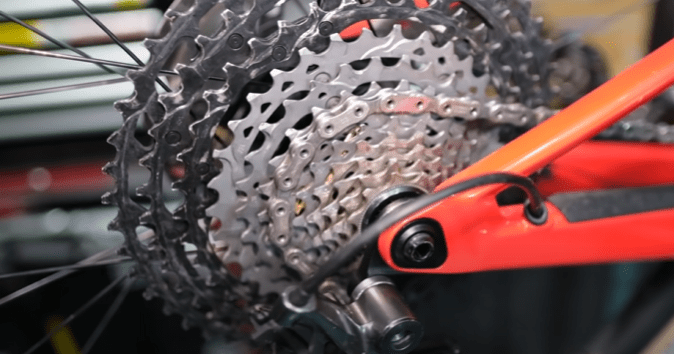

The upper screw on your derailleur is responsible for adjusting the chain drop. If you tighten it, the derailleur will move towards the wheel, and if you loosen it, it will move in the opposite direction.
To properly adjust your gears, you need to align the pulley with the smallest sprocket. You can achieve this by tightening or loosening the upper screw until the pulley is aligned correctly.
The next step is to adjust the top stop. To do this, you’ll need to push your derailleur until it reaches its limit. The optimal position is when the pulley is completely aligned with the largest sprocket. If it’s not aligned, you’ll need to make further adjustments by tightening or loosening until you reach the correct position.
It’s not common to adjust the derailleur bolts as they rarely get out of position. Typically, this task is only required when you’re installing a new derailleur.
If you’re not installing a new derailleur, you don’t need to adjust the bolts. However, it’s always a good idea to double-check the stop adjustment on your derailleur to ensure everything is working correctly.
Now it’s time to adjust the shifting. This can be accomplished by adding or removing tension from the cable using the tensioning wheels on the control or derailleur itself.
By increasing cable tension, it’ll be easier to shift to higher gears. However, it may be more difficult to shift to lower gears.
To adjust the shifting, place the chain on the second smallest sprocket and observe its behavior as you pedal. If it tends to shift up, the cable is too tight. If it shifts down instead, you need to add a bit more tension.
Adjusting the tension is a straightforward task, simply turn the small wheel forward to loosen or backward to tighten.
Continue adjusting the tension until you find the correct point, and you’re done. You now know how to adjust your bike’s shifting.
While we have covered the most important adjustments to the bike’s gearing, there are additional considerations worth noting.
When adjusting the bike’s derailleur, it is recommended to inspect other aspects that can impact the transmission’s performance. Check that the derailleur is securely attached to the frame and that the cables move smoothly within their covers. Also, maintain a distance of 6 to 8 mm between the top roller and the largest sprocket, which is achieved through a third screw on the derailleur that adjusts chain tension.
That’s all for now. Please feel free to ask any questions you have in the comments, and we’ll be happy to answer them.
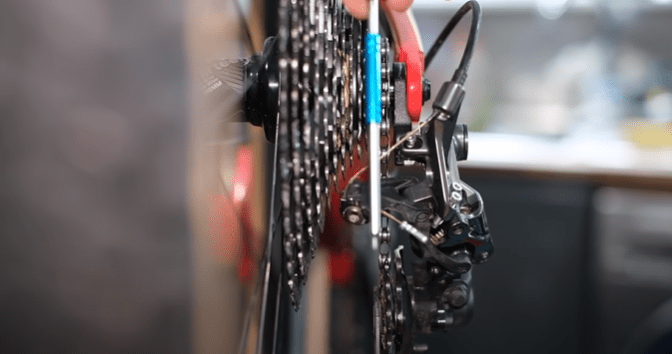

Shimano offers a variety of cross-drive groups in their product lineup, catering to different mountain biking specialties, including cross-country and downhill.
Currently, the Japanese brand has nine transmission groups, with two of them, the Saint and Zee, designed specifically for extreme mountain biking activities like dirt or downhill. The remaining groups can be installed on both rigid and dual suspension cross-country or enduro bikes, with components tailored to the specific bike usage. We’ll go over the features and applications of each group.
Shimano has three levels of gearboxes for entry-level bicycles, which are suitable for those who are new to the sport or use their bikes occasionally without much technical expertise.
Shimano Altus is a beginner-friendly mountain bike groupset that offers a smooth and reliable performance. Though it is Shimano’s entry-level option, it is still a great choice for those who are starting out in the sport of mountain biking. With its triple chainring development, it is suitable for simple walks and easy rides in the countryside.
The Altus cassette is 9-speed and comes in ranges of 11-32, 11-34, and 11-36. The shifters are simple yet efficient and include an analog gear display that lets the rider know which gear they are in at all times. Overall, the Shimano Altus is a great option for beginner riders who want a reliable and easy-to-use groupset for their mountain bike.
The Shimano Acera groupset is a step up from the entry-level Altus range. It is a reliable and intuitive transmission group, known for its smooth and precise gear changes.
It features easy-to-use shifters with an analog gear display, similar to the Altus. The Acera groupset also includes double and triple chainset cranks, with various development options including 36-22D and 44-32-22 or 40-30-22D.
The front derailleur uses Side Swing cable routing to provide smoother chainring changes, a technology found in higher-end groupsets. Additionally, the Shimano Acera groupset offers its own line of hydraulic disc brake levers and calipers.
The Shimano Alivio groupset is a great starting point for those looking to get into the sport of mountain biking. It’s commonly found on entry-level mountain bikes, and is priced similarly to the Shimano Deore groupset. The Alivio is known for being a reliable and simple shifting option that helps to keep the overall cost of the bike down.
One downside to the Alivio is that it doesn’t yet offer a 10-speed cassette, which is becoming increasingly necessary for modern mountain biking. However, it is still compatible with the 9-speed Altus or Acera groupsets, and comes with the option of a double or triple chainring.
In addition to the transmission group, the Shimano Alivio offers both hydraulic and mechanical disc brakes, as well as V-brakes for low-end mountain bikes.
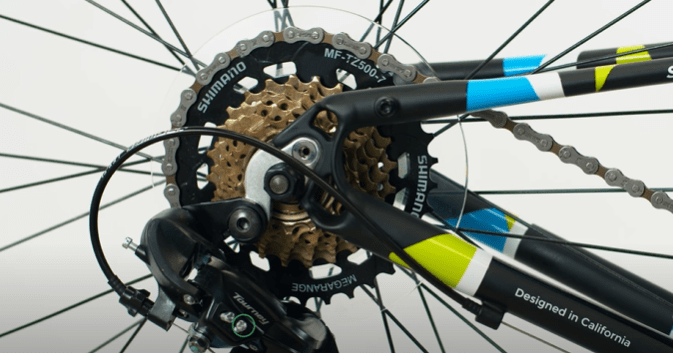

Shimano’s Deore and SLX derailleurs are highly popular and reliable mid-range options from the Japanese manufacturer. They are designed to adapt to various scenarios that mid-level cyclists may encounter.
The Shimano Deore group is a popular and best-selling mountain bike group in the manufacturer’s history. It is commonly found in low-to-mid-range bike assemblies.
The Deore M6100 series offers a significant upgrade in quality from the Alivio, including the all-new Deore 12-speed single chainring. It is an affordable option (with the complete group including disc brakes costing less than 450 Dollars) that brings the benefits of a 12-speed single-chainring transmission, typically found in higher-end ranges, to a wider range of cyclists.
The 12-speed cassette has a 10-51D development range and the cranks can mount 30 or 32 tooth chainrings, featuring the special Dynamic Chain Engagement+ teeth inherited from the upper SLX and XT groups.
The Deore also comes in 10-speed (cassettes 11-46 and 11-42) and 11-speed (cassettes 11-42 and 11-51) versions, with single or double chainrings, eliminating the triple option.
The rear derailleur incorporates Shadow RD+ technology with an adjustable stabilizer to prevent jumps and chain exits. The group also includes two or four-piston disc brakes, aluminum wheels in 27.5 and 29-inch sizes, and hubs.
The Shimano SLX is a great option for those looking for an affordable alternative to the Shimano Deore XT without sacrificing much in terms of shifting precision.
It features reliable components that work well on any type of MTB, from trails to training sessions. In addition, Shimano has created its own line of hydraulic disc brakes, hubs, and through axles to complement the SLX derailleur.
The latest version of the SLX group has been updated to 12 speeds, which directly competes with the mid-range SRAM Eagle (GX and NX). The group is now only offered in 1 × 12 and 2 × 12 development options.
The SLX cranks come in both double chainring (36-26D) and single chainring (30, 32, or 34D) options. The 12-speed cassette is available in two different range options: a 10-45D treadmill for double chainrings and a 10-51D scaler designed for single chainrings.
The SLX cassette is also lighter than the Deore series, making it easier to accelerate and reducing overall weight.
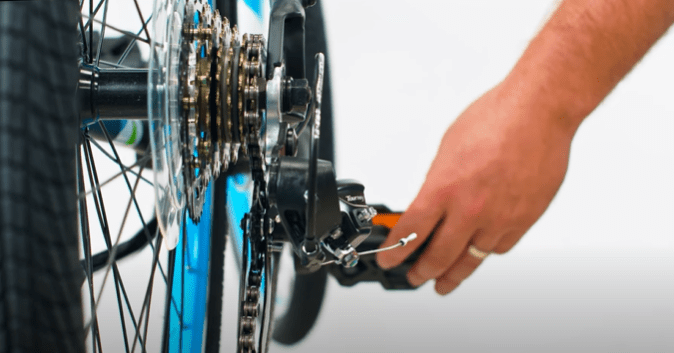

For cyclists who require a high-performance derailleur due to intense usage, Shimano offers two groups: Deore XT and XTR. These groups are available in both mechanical and electronic shift versions, but the electronic version features an 11-speed cassette and is currently not compatible with 1 × 12 transmissions.
Shimano’s Deore XT is not just a transmission group but also a benchmark in mountain bike components, including brakes, wheels, and pedals. Over the years, the Deore XT derailleur has transformed from a simple mid-range groupset to a more sophisticated and complete one that bridges the gap between amateur and professional MTB.
The Deore XT is reliable, fast, and offers outstanding value for money, making it a favorite among cyclists. It’s suitable for all types of mountain bike modalities and is perfect for intense training and competition.
Like other Shimano groups, the Deore XT has evolved to 12 speeds. The current series, M8100, offers the same development ratios as the SLX: 1 × 12 and 2 × 12. However, there are more cymbal options (28, 30, 32, 34, and 36D) and the same cassette (10-45D and 10-51D).
The Deore XT is lighter and more reliable than the Shimano SLX, with stiffer front and rear derailleurs. The rear derailleur has 13D sheaves with special anti-slip chain teeth and chain stabilizers (Shadow RD +), resulting in smooth, precise, quiet, and long-lasting transmission operation.
The Deore XT is also available in an electronic Di2 version, which inherits all the technology of electronic road groups but is adapted to the demands of MTB. However, the electronic version is only compatible with an 11-speed cassette.
Shimano XTR is a high-performance mountain biking groupset, comparable to Shimano’s Dura-Ace for road cycling. It has been around for over 25 years and is a go-to option for professional riders and high-end bike builds.
The XTR groupset is lightweight, precise, and functional, with an electronic Di2 version available. It uses a 12-speed cassette with single and double chainring options.
The XTR groupset features advanced technologies for quick gear changes, including Instant Release technology in the shifters and a special design in the rear derailleur for lower tension during gear changes, thanks to larger 13-tooth rollers.
The XTR groupset offers several crank options with a Hollowtech II hollow design, forged from aluminum to maximize stiffness and power transfer from the pedals. The single chainring options range from 30 to 38 teeth, larger than those of the SLX or Deore XT.
The 12-speed XTR cassette has a Beam Spider design, with three aluminum upper cogs and steel for the rest, making it lighter than comparable cassettes.
The XTR Di2 electronic version enhances the precision of all XTR components, thanks to its electronic drive system. The gearshift can be controlled from a digital display on the handlebar, showing the engaged gear, battery status, and preconfigured shift mode. However, it is only compatible with 11-speed cassettes.
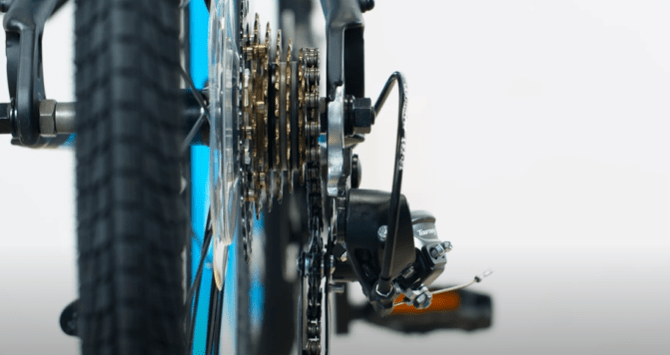

For riders who participate in Freeride or Downhill, Shimano provides two groups tailored to their needs: the Zee and the Saint.
The Shimano Zee is an introductory level groupset designed for novice riders, derived from the Saint. It features a unique ergonomic and non-slip push button, two sets of 1×10 thick-walled cranks, and a steel axle that boosts stability on rough terrain. Additionally, it includes a short cage rear derailleur, which is perfect for switching gear ratios.
The Zee-specific 10-speed cassette comes with a 10-25D range and Hyperglide teeth that ensure chain stability when shifting gears.
Shimano Saint is a complete range of components designed for high-performance downhill mountain biking. Apart from its unique transmission group, it also includes disc brakes (4 pistons), hubs, thru-axles, and pedals (both automatic and platform).
The Shimano Saint groupset has been thoroughly tested in the DH World Cup, and it features an integration unit for the shift lever. This adapter allows both the brake lever and the shift lever to be installed together, freeing up space on the handlebars and providing a more intuitive and quicker handling experience.
The cranks are made from the strongest possible Hollowtech II forging and have a steel axle, pedal inserts, and chainrings in 34, 36, and 38 tooth options.
The Saint offers two types of cassette, including the more conventional and versatile CS-M771-10 with 10 speeds and a range of 11-32 or 11-34. The other option is the most descending CS-6700 10v with a range of 11-25, 11-28, or 12-30D.
